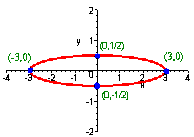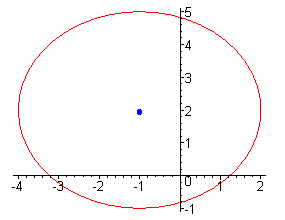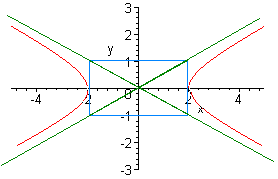Name
MAT 154A Practice Exam 3
Please work out each of the given
problems. Credit will be based on
the steps that you show towards the final answer.
Do all your work and give all your answers on you own sheet of paper.
Show your work.
Problem 1
Sketch the graphs of the given functions:
A.
x2
+ 4y2 = 1
9
Solution
First notice that this is an ellipse since both coefficients are positive. Putting the 4 in the denominator gives
x2
y2
+
= 1
9
1/4
So that
a = 3 b = 1/2
The vertices of the ellipse are at
(3,0), (-3,0), (0,1/2) (0,-1/2)
Now plot the points and sketch the ellipse.

B.
x2 + y2 + 2x - 4y
- 4 = 0
First complete the two squares
x2 + 2x + (1 - 1) + y2 - 4y + (4 - 4) - 4 = 0 Reordering and adding and subtracting b/2 to both
(x + 1)2 + (y - 2)2 = 9 Factoring, adding -1 - 4 - 4 = -9, and adding 9 to both sides
We recognize this as a circle with center (-1,2) and radius 3. The graph is given below

Problem
2
A. Find the first four terms of the sequence whose general term is given. Then find the 100th term.
an = n - 1/n
We have
a1 = 1 - 1/1 = 0
a2 = 2 - 1/2 = 3/2
a3 = 3 - 1/3 = 8/3
a4 = 4 - 1/4 = 15/4
a100 = 100 - 1/100 = 9999/100
B. Expand and simplify
![]()
We plug in 2, 3, 4, and 5 to get
[2(2) + 1] + [2(3) + 1] + [2(4) + 1] + [2(5) + 1]
= 5 + 7 + 9 + 11 = 32
C. Write the series in summation notation
1 2
3 4
+ +
+ + ...
2
3
4
5
The numerator is just n and the denominator is n + 1. Where n starts at 1 and continues to infinity. In summation notation, this becomes

Problem
3
A) Find the indicated unknown
8, 13, 18, 23, ..., 88 n = ?
This is an arithmetic sequence since
13 - 8 = 18 - 3 = 23 - 18 = 5
The common difference is d = 5.
The first term is 8, so the general formula is
an = 8 + 5(n - 1)
The last term is 88, so we set
88 = 8 + 5(n - 1)
80 = 5(n - 1) Subtract 8
16 = n - 1 divide by 5
n = 17 add 1
B) Find the sum of the given series
![]()
d = 3 a1 = 3 and n = 54
We use the sum of an arithmetic sequence formula to find the 54th term.
a54 = 3 + 3(54 - 1) = 162
The sum is
n/2 (a1 + an)
54/2 (3 + 162) = 4455
Problem
4
A. Find the indicated unknown
a1 = 5, a5 = 0.008 r = ?
This is a geometric sequence with
an = a1rn-1
We have
0.008 = 5r5-1
0.0016 = r4 Dividing by 5
r = ![]() (0.0016)1/4
=
(0.0016)1/4
= ![]() 0.2
0.2
B. A rubber ball is dropped on a hard surface and bounces to a height of 200 ft. On each rebound it bounces 95% as high as on the previous bounce. How high does the ball bounce on the 20th bounce?
We first write the first few terms of the sequence, which represents the height of the nth bounce.
a1 = 200 a2 = .95(200) a3 = .95(.95(200)) = .952(200)
We see that this is a geometric sequence with
an = 200(.95)n-1
We want the height of the 20th bounce. We have
a20 = 200(.95)19 = 75.5
The ball bounces about 75.5 feet on the 20th bounce
Problem
5
A. Find the sum of the infinite series if it exists.
1
1
1
1+
+ +
+ ...
3
9
27
This is a geometric sequence with first term 1 and common ratio r = 1/3. We have
a1
1
1
3
S
=
=
=
=
1 -
r
1 -
1/3
2/3 2
B. Write the repeating decimal as the ratio of two integers.
0.18
We write
0.18 = .18 + .0018 + .000018 + .00000018 +...
This is an infinite geometric sequence with
a1 = .18 = 18/100 and r = .01 = 1/100
We have
18/100
S =
1 - 1/100
18
=
Multiply top and bottom by
100
100 - 1
18
2
=
=
99
11
Problem 6
Find the equation of conic with the graph shown below:

Since this is a hyperbola centered at the origin, we need to determine a, b, and the signs. Since the hyperbola has x intercepts, the coefficient in front of x is positive. We have
a = 2, b = 1
The equation is
x2
y2
-
= 1
4
1
or
x2 - 4y2 = 4
Problem 7
Use Pascal's Triangle to expand
(3 - 2x)4
Solution
First create Pascal's Triangle
1
1 1
1
2 1
1 3
3 1
1 4 6
4 1
Next write out the powers starting out with the fourth power for the first term and the 0th power for the second. The first term powers decrease by one for each successive term and the second term powers increase by one for each successive term so that the sum of the two powers stays fixed at four.
34 33 (-2x) 32 (-2x)2 3(-2x)3 (-2x)4
Next insert the numbers from the fifth line of Pascal's triangle. Also add "+" signs because we are adding the terms.
(1)34 + (4) 33 (-2x) + (6) 32 (-2x)2 + (4) 3(-2x)3 + (1) (-2x)4
Next, perform the exponentiation.
81 + (4)(27)(-2)x + (6)(9)(4)x2 + (4)(3)(-8)x3 + (16)x4
Finally multiply out the coefficients
81 - 216x + 216x2 - 96x3 + 16x4
or
16x4 - 96x3 + 216x2 - 216x + 81
Problem 8
Solve the following:
A. log6(x - 5) + log6(x) = 2
Use the sum to product rule of logarithms
log6[(x)(x - 5)] = 2
(x)(x - 5) = 62 Remember logs are exponents
x2 - 5x = 36 Multiplying out
x2 - 5x - 36 = 0 Subtracting 36 from both sides
(x - 9)(x + 4) = 0
x = 9 or x = 4
Notice that 4 is not a solution since it is not in the domain of log6(x - 5). 9 is a solution, as you can verify with your calculator.
B. 22x-1 = 53x-2
Take ln of both sides
ln 22x-1 = ln 53x-2
(2x + 1) ln 2 = (3x - 2) ln 5 Using the power to product rule of logs
2x ln 2 + ln2 = 3x ln 5 - 2 ln 5 Multiplying out
2x ln 2 - 3x ln 5 = -ln 2 - 2 ln 5 Separating x terms to the left and others to the right
x(2 ln 2 - 3 ln 5) = -ln 2 - 2 ln 5 Factoring out the x
-ln 2 - 2 ln 5
x =
= 1.1365 Dividing by 2 ln
2 - 3 ln 5
2 ln 2
- 3 ln 5
C. Use a calculator to evaluate log7 51
First use the change of base formula
log
51
log7
51 =
log 7
Now put this in your calculator to get
2.02055867514
Problem 9
The clarity C (in feet) of Lake Tahoe t years since 1990 can be modeled by the equation
C(t) = 45e-t/25
A. How clear was the lake in 1995.
The year 1995 corresponds to t = 5. Plug this in for t to get
C(5) = 45e-5/25 = 36.84
The clarity of the lake was 36.84 feet in 1995
B. When will the clarity of the lake only be 5 feet?
Now plug in 5 for C to get
5 = 45e-t/25
1/9 = e-t/25 Dividing both sides by 45
ln(1/9) = ln(e-t/25) Taking the ln of both sides
ln(1/9) = -t/25 Cancelling the ln and the e
-25 ln(1/9) = t Multiplying both sides by -25
t = 54.93
Now turn this back into a date by adding it to 1990
1990 + 54.93 = 2044.93
We can say that towards the end of the year 2044 the clarity of the lake will be only 5 feet.
Problem 10
Solve the following system of nonlinear equations:
x2 + y2 = 25
3x + 5y = 15
We first solve the second equation for x by dividing by subtracting 5y and dividing by 3
3x = 15 - 5y
x = 5 - 5/3 y
Now substitute into the first equation to get
(5 - 5/3 y)2 + y2 = 25
25 - 50/3 y + 25/9 y2 + y2 = 25 FOIL
-50/3 y + 25/9 y2 + y2 = 0 Subtracting 25 from both sides
-150y + 25y2 + 9y2 = 0 Multiplying both sided by 9
34y2 - 150y = 0 Combining like terms
2y(17y - 75) = 0 Factoring out the GCF
y = 0 or y = 75/17 = 4.41
Now plug these solutions back into the equation
x = 5 - 5/3 y
to get
x = 5 - 5/3 (0) or x = 5 - 5/3 (75/17)
x = 5 or x = 5 - 125/17 = -40/17 = 2.35
Our two solutions are (5,0) and (2.35,4.41)
Problem 11
Graph the solution to the system of nonlinear inequalities
x2 - y2 < 1
x
> y2
Solution
First we graph the two curves. Graph the first with a solid curve and the second with a dashed curve, since when the inequality includes "=" the curve is included and we write a solid curve. When it doe not include the "=", we write a dashed curve. The first curve is a hyperbola with x-intercepts since the positive belongs to the x term. The second curve is a sideways parabola. The graph is shown below.

We can see that there are six regions. Next choose test points to see which regions should be shaded. The left region's test point is (-2,0). The first inequality is false thus we do not shade this region. The middle region's test point is (0,2). The second inequality is false, so this region also should not be shaded. The next region's test point is (0.5,0). Both inequalities are true, so we shade this region. The top right region's test point is (2,2). The second inequality is false, so we do not shade this region. The top bottom region's test point is (2,-2). the second inequality is false, so we do not shade this region. The right region's test point is (2,0). The first inequality is false, so this region is not included. Thus the only region that is included is the region to the right of the parabola and the left of the right branch of the hyperbola. The solution graph is shown below.
